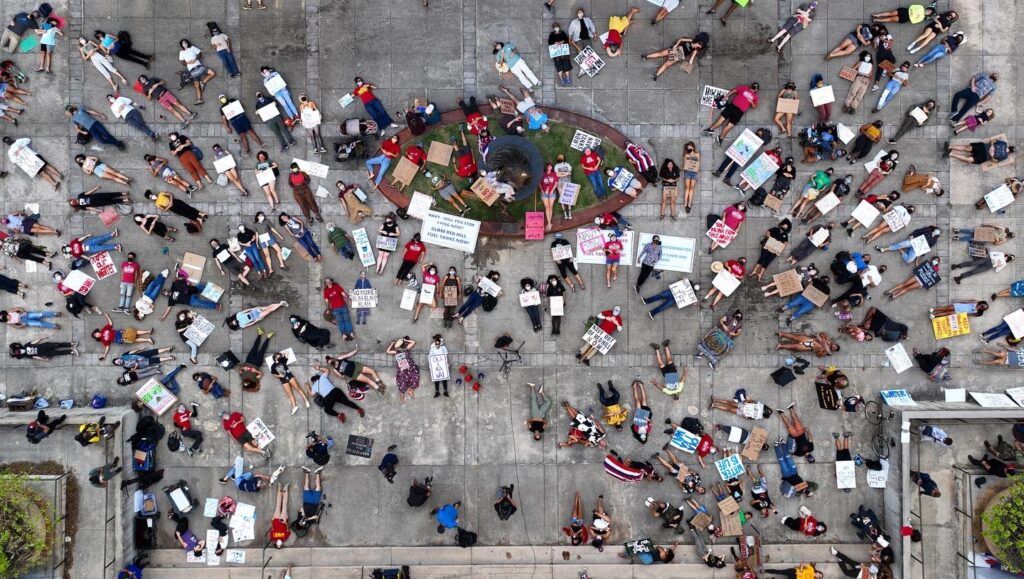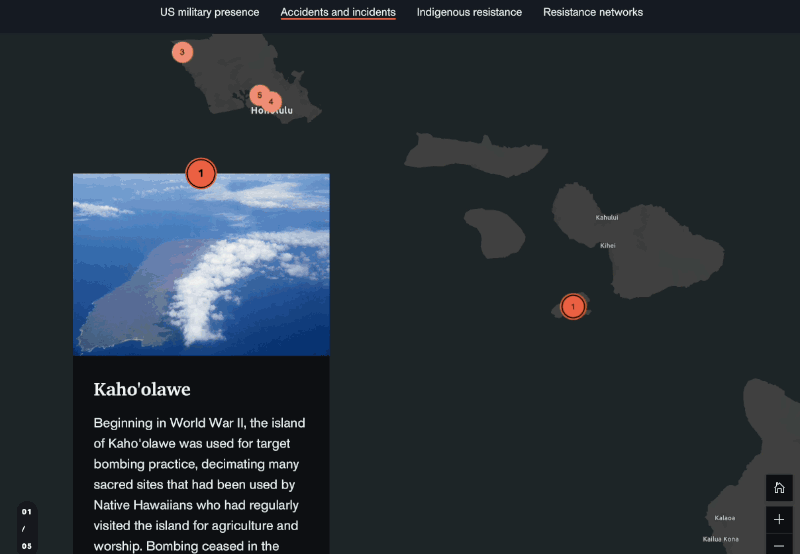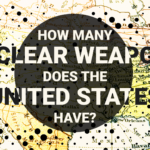Lessons for confronting deterrence and militarism from Hawaii, America’s ‘unsinkable aircraft carrier’
By Tamara Lilinoe Patton | October 11, 2023
 A ko'a, or traditional Hawaiian shrine, erected Dec. 12, 2021, in front of the entrance to the US Navy Pacific Fleet headquarters, part of demonstrations against pollution of water from a military jet fuel leak into O'ahu's aquifer. (Photo: Bradford Nakamura)
A ko'a, or traditional Hawaiian shrine, erected Dec. 12, 2021, in front of the entrance to the US Navy Pacific Fleet headquarters, part of demonstrations against pollution of water from a military jet fuel leak into O'ahu's aquifer. (Photo: Bradford Nakamura)
Maui’s runaway wildfires this summer have made America aware of the vulnerability of Hawaii to fast and fierce destruction wrought by a combination of natural and human causes. But public concern about an isolated incident of tragedy on Hawaii—best known as a tropical paradise of happy natives or a now-mythical military base that was attacked (Pearl Harbor)—misses the slow structural violence and decimation that has been wrought there by colonization, industrialization, militarism, and climate change.
For decades, the US military has built up and managed a robust presence in the Pacific region (also known as Oceania), with a high concentration of bases and other structures to support nuclear and conventional weapons missions. Hawaii sits at the heart of this vast military archipelago, which includes key sites in Guam and the Marshall Islands; all have had heavy investment in infrastructure and military exercises, missile tests, and, for the Marshalls, even nuclear weapon testing during the Cold War.
Now, amid US policies shaped by a vision of conventional and nuclear competition with China, new US bases are planned for the Federated States of Micronesia and Palau. Unless reversed, this militarized perspective may dominate the future of Oceania for decades. One example of planning to deter China in the Pacific is the US Air-Sea Battle doctrine, now known at the Joint Concept for Access and Maneuver in the Global Commons (JAM-GC). This integrated battle doctrine sees a wide variety of US forces working in coordination over a vast area to address asymmetrical threats from China.
A recent US Air Force analysis suggests that “many potential sites across the Indo-Pacific must be thoroughly analyzed and constructed to meet the need for a rapid introduction of forces.” The report notes that the islands of the Pacific may serve as “unsinkable aircraft carriers,” using a term that has been historically employed to erase an Indigenous presence and replace it with a technostrategic construction.
This American security framework is being challenged by scholars, activists, and a large faction of the international community that supports the Treaty on the Prohibition of Nuclear Weapons and parallel anti-nuclear weapons efforts. But the notion of deterrence as security is also being challenged more immediately by the Indigenous people living on America’s unsinkable aircraft carriers in the Pacific, who are increasingly asserting their right to have a home that is not a battleship but part of nature. Their perspective offers an alternative security imagination, one based on the pursuit of social, environmental, and climate justice rather than militarism and deterrence. These Indigenous visions of security could inform a wider security rethink and help enable more people and countries to reject nuclear deterrence as a means to a secure world.
How military activity has harmed Hawaiians. In the Indigenous Hawaiian perspective, deterrence is not a natural or universal notion but an idea and practice connected to Western military and colonial presence. For centuries, the Indigenous peoples of Oceania have had their homelands, including entire islands or atolls, confiscated and contaminated for the purposes of military infrastructure, testing, or training. These same lands are now being engulfed by rising seas stemming from uncontrolled industrialization, the consequences of which are often experienced unevenly by native and settler communities.
The Indigenous resistance to the US government’s militarized view of security in the Pacific works through an intersectional approach that incorporates elements of the social, environmental, and climate justice movements and addresses the harms of militarism, colonization, and industrialization. It also is sensitive to the everyday (rather than catastrophic) operation of militarism in Oceania, which has resulted in numerous accidents and incidents of pollution and contamination.
In Hawaii, historical cases of harm through militarism include the bombing of the island of Kaho’olawe from World War II through 1990. This decimated many sacred sites that had been used by Native Hawaiians who had regularly visited the island for agriculture and religious reasons. Another example is the contamination of the Pohakuloa training area through the use of depleted uranium (DU) weapons, including non-explosive test rounds used to determine the accuracy of the Davy Crockett tactical nuclear weapon. Due to increased traffic, strong winds in the area, and occasional flash flooding, there has been an increase in potential pathways of public exposure to DU aerosol particles and potential transport of DU around the island.
Military activity has also displaced Native Hawaiians. The US military has occupied parts of Oahu’s Mākua Valley since the 1920s and uses the area for ammunition testing. As military activity expanded, Native Hawaiians living in the area were evicted over decades, including through mass arrests, and the Mākua Valley is at the center of an ongoing land rights dispute between Native Hawaiians and the US military.
In 2021, a major petroleum leak from the US Navy’s Red Hill Fuel Facility on O’ahu poisoned groundwater in the area—and thousands of people. The O’ahu Water Protectors—a network of nongovernmental organizations, academics, and citizens—says that the Red Hill incident has left thousands of homes uninhabitable, but only military families are receiving help, with many civilians living with dangerous water, and without acknowledgment from the military or their landlords.
Militarism and deterrence have also at times had psychological ramifications. On 13 January 2018, a ballistic missile SMS alert was accidentally issued to the entire state population, which read: “Ballistic missile threat inbound to Hawaii. Seek immediate shelter. This is not a drill.” Thirty-eight minutes later, state officials announced that the alert was a mistake—after panicked citizens had scrambled to try to deal with what they believed was an incoming nuclear attack. Hawaii was recognized by emergency planners as a target because it is a key part of the US nuclear and conventional war making complex in the Pacific. It is expected that adversaries will attack it.
Indigenous Hawaiian resistance movements have a long history and have evolved over time. During the years of fighting against the target bombing on Kaho’olawe, much of the discourse focused on the pursuit of Hawaiian sovereignty. Since then, Indigenous movements have shifted to calling for demilitarization. This comes across most clearly in the sweeping fight for clean water in the context of the Red Hill Fuel Facility incident, where academics, researchers, and members of the public have come together to call for reorienting resources from militaries to social, environmental, and climate causes. These recent calls for demilitarization also stand as a contemporary amplification of a longer history of protests against militarism and nuclear weapons, such as the Nuclear Free and Independent Pacific movement throughout Oceania.

The Na`au Pono and malama ‘aina alternative. While Indigenous resistance contests the lived experience of the harms of Washington’s militarism, Indigenous pursuits of social, environmental, and climate justice also can be seen as threads of an alternative security imagination. One guiding idea is the Hawaiian concept of “Na`au Pono.” “Na`au” means intuition, a gut feeling. To be “pono” is to do good to and for all, to be balanced and understanding. As a whole, this phrase means following one’s instincts for the betterment of humanity and the environment. Several other core principles of Hawaiian society and organization also offer elements of this alternative security narrative.
The traditional Hawaiian model of land organization is still a foundation for thinking about social and environmental justice today. Land was divided into “ahupua’a,” pieces of land that stretched from the central mountains to the coast, such that each community had access to mountain, agricultural, and ocean areas. Translated to the present, the ahupua’a framework could serve as a model to promote sustainable and accessible forms of community farming, agriculture, aquaculture, and fishing—rather than Western economists’ ideas of comparative advantage through specialization and monoculture.
For Native Hawaiians, access to diverse regions of the land and sea come with a deep sense of responsibility to care for the land as a family member. This is embodied in the words “malama ‘aina,” meaning to care for the land. Hawaiian practices for agricultural engineering revolve around putting sustainability at the forefront of land development. Today, researchers are studying how the ancient “hydraulic engineers” of Hawaiʻi created sustainable and highly productive agricultural systems that endured for centuries.
Historically, nonviolence and cooperation were also core elements of Hawaiian governance. The phrase “Ua Mau ke Ea o ka ʻĀina i ka Pono” means that the life/breath/sovereignty of the land is perpetuated in righteousness. The motto of the Native Hawaiian government, the phrase embodies the deeply felt idea that both collective and individual well-being are achieved through decency and integrity toward others, and including the land as a family member of the community.
These Native Hawaiian concepts go beyond tradition. Today’s Indigenous resistance efforts draw together contemporary and ancient practices and technologies in an effort to resist further decimation of Indigenous bodies, lands, and cultures. This contemporary Hawaiian Indigenous effort embodies a vision of even tighter linkage between social, environmental, and climate justice as an alternative vision for security and shifts emphasis from national sovereignty for Native Hawaiians to a broad rejection of militarization and deterrence posturing.
This Indigenous approach reveals what one model for security through disarmament could mean. It calls for the reorienting of identities and resources from militarism and weapons toward common, core global community-centered security challenges like environmental remediation for public welfare and sustainability efforts that address climate change and facilitate local, national, and international cooperation. It’s an approach that will be worth wider consideration and study long after the firestorm in Maui disappears from news headlines.
Acknowledgment: This work was supported in part by the Ploughshares Fund’s Equity Rises Initiative. The author would also like to thank members of Princeton’s Program on Science and Global Security and members of the Beyond Nuclear Deterrence Working Group—a research network funded by the MacArthur Foundation and housed at Harvard University’s Belfer Center for Science and International Affairs—for their input and feedback.
Together, we make the world safer.
The Bulletin elevates expert voices above the noise. But as an independent nonprofit organization, our operations depend on the support of readers like you. Help us continue to deliver quality journalism that holds leaders accountable. Your support of our work at any level is important. In return, we promise our coverage will be understandable, influential, vigilant, solution-oriented, and fair-minded. Together we can make a difference.
Keywords: Guam, Kaho’olawe, Marshall Islands, Micronesia, Mākua Valley, Na`au Pono, Oceania, Palau, Pohakuloa, Red Hill Fuel Facility
Topics: Nuclear Weapons, Special Topics

















Aloha, I am from Maui. I am Native American and a little Hawaiian. I have a small farm, and my ancestors have always farmed/ranched. I am also retired Army with combat time and Hawaii National Guard. My graduate work is National Security. I can’t say enough great things about this article. You covered so many issues. I have been stating that maybe if we were sovereign, we could stop this increase in weapons around the islands, around the Pacific. Also, thank you for mentioning the Ahupua’a. My grandmother Nani used to say “if you take care of the aina it… Read more »